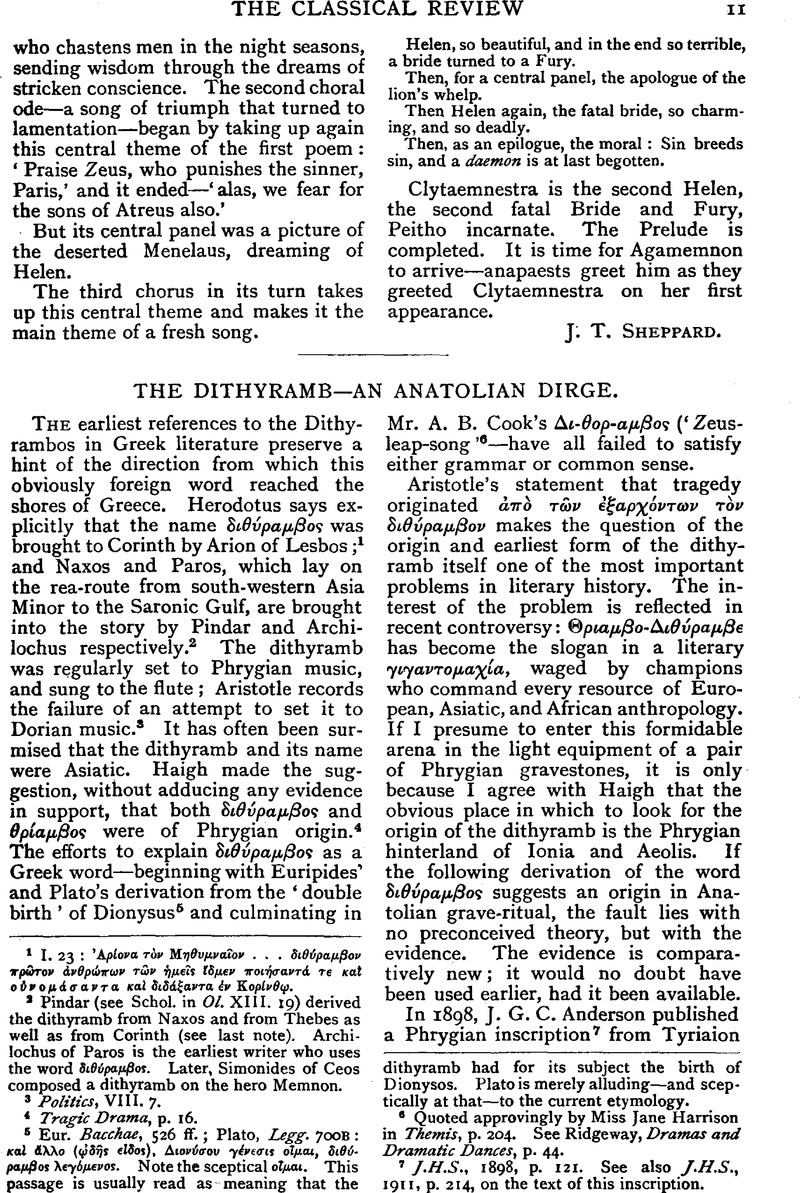No CrossRef data available.
Article contents
The Dithyramb—an Anatolian Dirge
Published online by Cambridge University Press: 27 October 2009
Abstract

- Type
- Review Article
- Information
- Copyright
- Copyright © The Classical Association 1922
References
page 11 note 1 1. 23: ![]() .
.
page 11 note 2 Pindar (see Schol. in 01. XIII. 19) derived the dithyramb from Naxos and from Thebes as well as from Corinth (see last note). Archilochus of Paros is the earliest writer who uses the word διθúpαμβoς. Later, Simonides of Ceos composed a dithyramb on the hero Memnon.
page 11 note 3 Politics, VIII. 7.
page 11 note 4 Tragic Drama, p. 16.
page 11 note 5 Eur. Bacchae, 526 ff.; Plato, Legg. 700B:![]() . Note the sceptical οῖμαι. This passage is usually read as meaning that the dithyramb had for its subject the birth of Dionysos. Plato is merely alluding—and sceptically at that—to the current etymology.
. Note the sceptical οῖμαι. This passage is usually read as meaning that the dithyramb had for its subject the birth of Dionysos. Plato is merely alluding—and sceptically at that—to the current etymology.
page 11 note 5 Quoted approvingly by MissHarrison, Jane in Themis, p. 204Google Scholar. See Ridgeway, , Dramas and Dramatic Dances, p. 44.Google Scholar
page 11 note 7 J.H.S., 1898, p. 121. See also J.H.S., 1911, p. 214, on the text of this inscription.
page 12 note 1 J.H.S., 1911, p. 188.
page 12 note 2 Revue de Philologie, 1912, p. 51. The clinching text is ![]() (Iconium).
(Iconium).
page 12 note 3 I take κα to be a dialectic variety of κε. The interpretation of the later Phrygian inscriptions owes most to Ramsay's paper on Jahresh. Oest. Arch. Inst, 1905, col. 79 ff., where much new material is added to the same writer's collection in Kuhns Zeitsch. XXVIII., pp. 381 ff. Further fresh material was utilised in J.H.S., 1911, pp- 161 ff., and 1913, pp. 97 ff.See also Fraser, , Phrygian Studies in Trans. Camb. Phil. Soc, 1913Google Scholar, and Richard Meister in Xenia Nicolaibana (ca. 1912). For a full discussion of the two inscriptions quoted above see J.H.S., 1911, pp. 178, 188, 214.
page 12 note 4 Except, perhaps, in No. LXV.; but this is very doubtful.
page 13 note 1 J.H.S., 1911, p. 166, No. IV.
page 13 note 2 That θáλαμoς or θαλáμη is an old Anatolian word, borrowed thence by both Greek and Phrygian, appears from the following passages:
(I) Hesychius, ![]() (which were evidently buried in a grave under a monument with a stêlê—the whole custom is Anatolian, and Phrygian by adoption). (2) Hesychius,
(which were evidently buried in a grave under a monument with a stêlê—the whole custom is Anatolian, and Phrygian by adoption). (2) Hesychius, ![]() .
.
page 13 note 3 Note Μιτρα-, not Μιθρα.
page 13 note 4 Jahresh. Oest. Arch. Inst., 1905, col. 89.
page 13 note 5 We should in this case have to regard διθρεψα as a mistake for διθρερα; but even on the assumption that the root is ‘dithre-,’ διθρερα is a difficult form.
page 14 note 1 See Miss Ramsay in Studies in the E.R. Prov., p. 65, where references are quoted.
page 14 note 2 This is Ramsay's suggestion. He compares the term δíπυλον, applied by Plutarch (II. 322B), to the temple of Janus.
page 14 note 3 Kretschmer, , Einleitung, p. 303Google Scholar; cf. p. 404.
page 14 note 4 See Reinach, A., Noé Sangarion, p. 73.Google Scholar
page 14 note 5 I assume an identification which implies a new theory of the march of Manlius, which I hope soon to publish.
page 14 note 6 Cities and Bishoprics, p. 347.
page 14 note 7 See Kretschmer, op. cit., p. 336, and addhis references Ἀββουκώμη in an unpublished inscription of Laodicea Combusta at Kadyn Khan.


